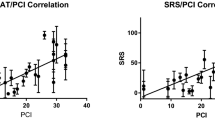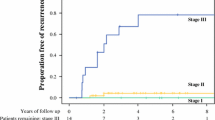Abstract
Background
MD Anderson Cancer Center developed a computed tomography (CT)-based preoperative assessment tool simplified preoperative assessment for appendix tumor (SPAAT) for predicting incomplete cytoreduction (IC) in low-grade mucinous adenocarcinoma (LGMA) of the appendix, based on preoperative CT scans. This study independently evaluates the tool’s performance.
Methods
Seventy-six preoperative CT scans of LGMA patients were evaluated by two surgeons unfamiliar with the patients’ medical history. Scores were assigned based on SPAAT criteria, with a SPAAT ≥3 predictive of IC. Binary regression analyses and area under the receiver operating characteristic (AUROC) curve analyses were performed. Patients with splenic resection were excluded due to the structure of the SPAAT assessment tool.
Results
Seventy-six LGMA patients underwent attempted cytoreductive surgery with hyperthermic intraperitoneal chemotherapy (CRS/HIPEC). Of 68 patients, 58 had complete cytoreduction and 10 had IC; 8 patients were ineligible due to prior splenectomy. The mean SPAAT score was 0.8, with six patients having SPAAT scores ≥3. SPAAT scores ≥3 were predictive of IC, with a hazard ratio (HR) of 19 (95% confidence interval 2.8–124.1) (p = 0.002). Sensitivity, specificity, positive predictive value (PPV), and negative predictive value were 40, 97, 50, and 90%, respectively. A SPAAT score ≥3 was not associated with worse survival prognosis. Median follow-up was 2.4 years and AUROC curve was 71%. SPAAT components with respective HR and p-values were foreshortening of the bowel mesentery (29.5; p = 0.004), and scalloping of the pancreas (9; p = 0.008), spleen (4.3; p = 0.04), portal vein (3.1; p = 0.4), and liver (2.1; p = 0.3).
Conclusion
A SPAAT score ≥3 predicted IC based on a binary regression model. The clinical value of this score is controversial due to low sensitivity and PPV.
Similar content being viewed by others
References
Chua TC, Moran BJ, Sugarbaker PH, et al. Early- and long-term outcome data of patients with pseudomyxoma peritonei from appendiceal origin treated by a strategy of cytoreductive surgery and hyperthermic intraperitoneal chemotherapy. J Clin Oncol. 2012;30(20):2449–56.
Sugarbaker PH. Epithelial appendiceal neoplasms. Cancer J. 2009;15(3):225–35.
Dineen SP, Royal RE, Hughes MS, et al. A simplified preoperative assessment predicts complete cytoreduction and outcomes in patients with low-grade mucinous adenocarcinoma of the appendix. Ann Surg Oncol. 2015;22(11):3640–6.
Ronnett BM, Zahn CM, Kurman RJ, Kass ME, Sugarbaker PH, Shmookler BM. Disseminated peritoneal adenomucinosis and peritoneal mucinous carcinomatosis. A clinicopathologic analysis of 109 cases with emphasis on distinguishing pathologic features, site of origin, prognosis, and relationship to “pseudomyxoma peritonei”. Am J Surg Pathol. 1995;19(12):1390–408.
Jacquet P, Sugarbaker PH. Clinical research methodologies in diagnosis and staging of patients with peritoneal carcinomatosis. Cancer Treat Res. 1996;82:359–74.
El HH, Gushchin V, Francis J, et al. The role of cytoreductive surgery and heated intraperitoneal chemotherapy (CRS/HIPEC) in patients with high-grade appendiceal carcinoma and extensive peritoneal carcinomatosis. Ann Surg Oncol. 2012;19(1):110–4.
Halabi HE, Gushchin V, Francis J, et al. Prognostic significance of lymph node metastases in patients with high-grade appendiceal cancer. Ann Surg Oncol. 2012;19(1):122–5.
Jacquet P, Jelinek JS, Steves MA, Sugarbaker PH. Evaluation of computed tomography in patients with peritoneal carcinomatosis. Cancer. 1993;72(5):1631–6.
Chua TC, Al-Zahrani A, Saxena A, et al. Determining the association between preoperative computed tomography findings and postoperative outcomes after cytoreductive surgery and perioperative intraperitoneal chemotherapy for pseudomyxoma peritonei. Ann Surg Oncol. 2011;18(6):1582–9.
Disclosure
Vladimir Milovanov, Armando Sardi, Nail Aydin, Carol Nieroda, Michelle Sittig, and Vadim Gushchin disclose no financial and personal relationships with other people or organizations that could inappropriately bias their work.
Author information
Authors and Affiliations
Corresponding author
Rights and permissions
About this article
Cite this article
Milovanov, V., Sardi, A., Aydin, N. et al. External Validation of the Simplified Preoperative Assessment for Low-Grade Mucinous Adenocarcinoma of the Appendix. Ann Surg Oncol 24, 1783–1786 (2017). https://doi.org/10.1245/s10434-017-5794-6
Received:
Published:
Issue Date:
DOI: https://doi.org/10.1245/s10434-017-5794-6




